Answer:
Approach:
- Introduction: Briefly introduce the India-Middle East-Europe Economic Corridor (IMEC) and its announcement at the G20 Summit.
- Body:
- Discuss the strategic significance of IMEC in India’s Foreign Policy.
- Talk about the Economic Interests.
- Also, compare with China’s Belt and Road Initiative (BRI) in terms of regional influence and connectivity.
- Conclusion: Emphasise the importance of collaboration and successful implementation for maximising IMEC’s impact.
|
Introduction:
The India-Middle East-Europe Economic Corridor (IMEC) is a transformative infrastructure initiative aimed at enhancing connectivity and economic integration across Asia, the Arabian Gulf, and Europe. Announced at the G20 Summit in 2023, IMEC signifies a strategic shift in global trade routes and has far-reaching implications for India’s foreign policy and economic interests.
Body:
Strategic Significance in India’s Foreign Policy

- Geopolitical Leverage: IMEC enhances India’s influence in the Middle East and Europe, providing a counterbalance to China’s Belt and Road Initiative (BRI).
- This positions India as a pivotal player in global geopolitics, fostering stronger ties with key partners like the UAE, Saudi Arabia, and the EU.
- Strengthening Alliances: By collaborating with the US, UAE, Saudi Arabia, and European nations, IMEC strengthens India’s strategic alliances.
-
- This cooperation showcases India’s ability to lead and participate in significant international projects, reinforcing its global standing.
- Security and Stability: IMEC is projected to enhance regional stability by fostering economic interdependence.
- Improved connectivity and economic ties can mitigate political tensions in the Arabian Peninsula, promoting peace and stability in the region.
- Diversified Energy Routes: The corridor includes plans for energy pipelines, enhancing India’s energy security by diversifying its energy import routes.
- This reduces reliance on any single region and ensures a steady supply of energy resources.
- Global Supply Chain Integration: IMEC aims to integrate regional supply chains, making them more resilient and efficient.
- This integration is crucial for India’s manufacturing sector, which relies on stable and predictable supply chains for raw materials and components.
Economic Interests
- Trade Enhancement:
- Facilitates smoother, faster trade routes between India, the Middle East, and Europe.
- Reduces transit times and costs, boosting India’s export potential in textiles, pharmaceuticals, and IT services.
- Investment Opportunities:
- Attracts substantial foreign investment into India’s infrastructure projects.
- Creates economic growth and job opportunities through public and private sector investments.
- Technological Advancements:
- Promotes high-speed data cables and digital connectivity.
- Supports India’s vision of becoming a digital economy.
- Tourism Growth:
- Enhances connectivity and infrastructure, spurring tourism between India, the Middle East, and Europe.
- Benefits India’s hospitality and service sectors with easier travel routes.
- Logistics and Supply Chain Efficiency:
- Integrates transport networks, including railroads and shipping lines.
- Streamlines logistics and supply chain operations, improving cost-efficiency and global competitiveness.
Comparison with China’s Belt and Road Initiative (BRI)
- Strategic Objectives: While both IMEC and BRI aim to enhance connectivity, IMEC is seen as a more collaborative and transparent initiative involving multiple stakeholders, whereas BRI has been criticized for creating debt dependencies and exerting Chinese influence over participant countries.
- Regional Influence: IMEC provides a viable alternative to BRI, particularly for countries wary of China’s strategic intentions.
- By involving diverse international partners, IMEC promotes a multipolar world order and reduces the dominance of any single country in global trade routes.
- Economic Integration: Both initiatives seek to integrate regional economies, but IMEC emphasizes sustainability and inclusive growth, aligning with global standards for infrastructure development and environmental considerations.
- This focus can attract countries seeking more balanced and equitable partnerships.
- Connectivity Infrastructure: IMEC’s focus on high-speed data cables, energy pipelines, and modern transportation networks aligns with future-oriented infrastructure development, contrasting with BRI’s traditional emphasis on physical infrastructure like roads and bridges.
- Political Stability: IMEC aims to foster political stability through economic integration and connectivity, leveraging partnerships to reduce regional tensions. BRI, on the other hand, has faced criticism for exacerbating geopolitical rivalries and fostering dependency.
Conclusion:
The India-Middle East-Europe Economic Corridor holds substantial promise for India’s foreign policy and economic interests, offering strategic advantages and fostering economic growth. By providing a viable alternative to China’s BRI, IMEC can enhance regional influence and connectivity, contributing to a more balanced and multipolar global order. Moving forward, successful implementation and collaboration among partner nations will be crucial to realizing IMEC’s full potential.
To get PDF version, Please click on "Print PDF" button.


Latest Comments